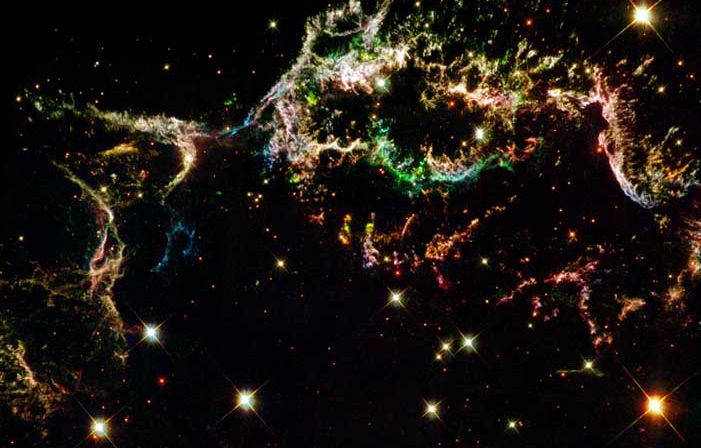Credit & Copyright: Hubble
Heritage Team
(STScI /
AURA),
R. Fesen
(Dartmouth)
and J. Morse
(CASA, U. Colorado),
NASA
Explanation:
For billions of years,
massive stars in our Milky Way
Galaxy have lived spectacular lives.
Collapsing from vast cosmic
clouds, their nuclear furnaces
ignite and create heavy elements in their cores.
After a few million years, the
enriched material is blasted
back into interstellar space where star formation
begins anew.
The expanding debris cloud known
as
Cassiopeia A is an example
of this final phase of the stellar life cycle.
Light from the explosion which created this supernova remnant was
probably first
seen
in planet Earth's sky just over 300 years ago,
although it took that light more than 10,000 years to reach us.
In this gorgeous
Hubble Space Telescope image of cooling filaments
and knots in the Cas A remnant, light
from specific elements has been color coded to help astronomers
understand the recycling of our galaxy's
star stuff.
For instance, red regions are dominated by emission from sulfur atoms
while blue shades correspond to oxygen.
The
area shown is about 10 light-years across.
1998 1999 2000 2001 2002 2003 2004 2005 2006 2007 2008 2009 2010 2011 2012 2013 2014 2015 2016 2017 2018 2019 2020 2021 2022 2023 2024 |
Январь Февраль Март Апрель Май Июнь Июль Август Сентябрь Октябрь Ноябрь Декабрь |
NASA Web Site Statements, Warnings, and Disclaimers
NASA Official: Jay Norris. Specific rights apply.
A service of: LHEA at NASA / GSFC
& Michigan Tech. U.
|
Публикации с ключевыми словами:
Cas A - supernova remnant - stellar evolution - massive stars - остаток Сверхновой - Эволюция звезд - массивные звезды
Публикации со словами: Cas A - supernova remnant - stellar evolution - massive stars - остаток Сверхновой - Эволюция звезд - массивные звезды | |
См. также:
Все публикации на ту же тему >> | |
